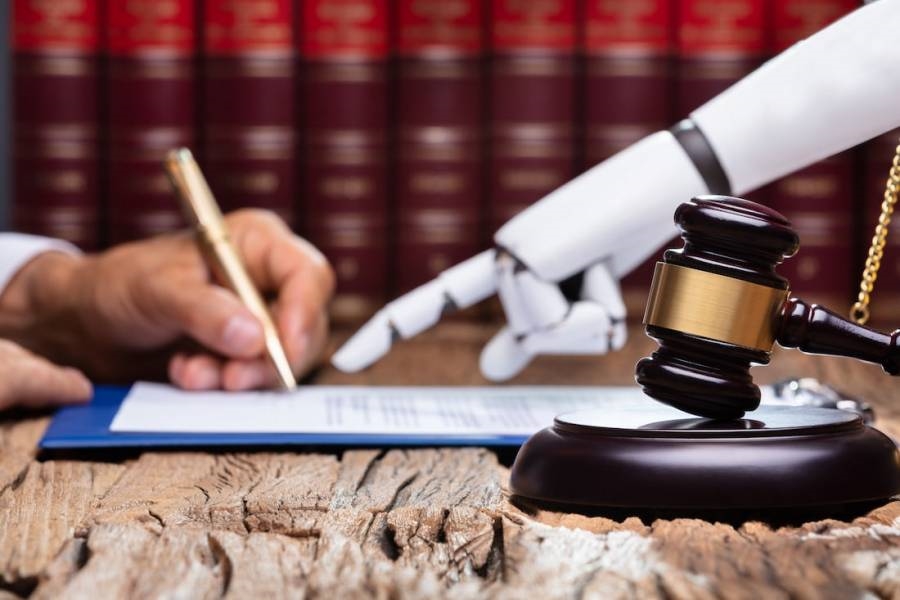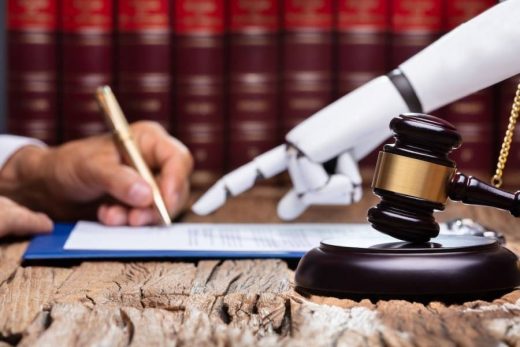Legal Industry Slowly Catching up with the Opportunities of AI and ML
Legal Industry Slowly Catching up with the Opportunities of AI and ML

Science fiction films like 2001 A Space Odyssey and The Terminator portray Artificial Intelligence (AI) and Machine Learning (ML) as advanced technologies poised to overtake humankind in apocalyptic scenarios.
Fictitious depictions of AI and ML make for great theater.
The fictitious depiction of AI and ML are fun to watch and they generate high box office receipts. However, they neglect the practical uses and benefits of AI and ML as business drivers.
AI and ML technologies are the most potent forces behind the digital transformation of business today with no signs of slowing down.
Across every industry vertical, AI and ML are empowering people to redefine how data is collected, integrated, transformed and analyzed for more accurate insights and outcomes.
AI and ML have widespread adoption in quantitative, science or math-based industry verticals. Industries like medicine, finance and banking, insurance, software, and the automotive industry.
Many early adopters are embarking on the second generation of AI and ML initiatives having realized positive returns on early investments. These early adopters usually operate in innovative, forward-thinking industries. They need to quickly respond to consumer demand.
Industries like medicine, software, and other high-demand tech platforms have to respond almost instantaneously. We’ve witnessed how quick responses generate competitive differentiators in crowded spaces like banking and finance and insurance.
The slow adopters have discovered that they must adopt AI and ML to remain competitive.
Slow adopters of AI and ML have lagged behind. Not because of a lack of intrinsic value of AI and ML to the industry or its participants, but because of the characteristics of the entire industry. These industries tend to be price inelastic with significant barriers to entry. They also have highly customized product and service offerings.
The Legal Industry AI and ML Adoption
A prime example of an industry with this dynamic and how it is playing “catch-up” is the legal industry. Why are legal industry leaders finally starting to pay attention? Because they want to survive…
Until recently, legal services were consultative, qualitative, and “non-productized” in nature. Experience reigned superior. Technical skills are important, but one of the primary benefits of hiring very experienced outside counsel has been to leverage their extensive experience.
A client who has hired counsel with thirty or forty years of experience benefits from a historically guided litigation strategy. Time-tested negotiation tactics have served as a surrogate for AI and ML.
AI and ML applied to data.
Now that AI and ML is being applied to the data, they’re eclipsing the value of a seasoned attorney’s experience.
Deloitte estimates that over 100,000 roles within the legal industry will be automated by 2036. To survive, law firms are realizing that they must become AI-ready.
Being AI-ready means adopting a mindset of innovation. Confronting the fear of technological failure. And, most of all, training a workforce on best AI/ML practices within the legal community. As the legal industry continues to re-imagine itself, and this innovation is transforming it.
Two Distinct Offerings Have Emerged in the Legal Industry
In today’s legal industry two distinct offerings of “legal solutions” have emerged:
1) The practice of law
2) The business of delivering legal services. Clients now receive a hybrid qualitative/quantitative mix of legal services.
The legal industry’s status quo mentality is being replaced with innovation because client’s are demanding it.
A new buy/sell dynamic is emerging where client expectations of how, from whom, and at what price legal services are bought and sold is being re-imagined.
Against this backdrop, AI and ML are mimicking certain operations of the human legal mind. It’s also completing tasks that have typically required human intelligence.
AI and ML aren’t going to completely replace humans in the legal industry in the near future. These systems can’t yet replicate advocacy, negotiation, or structuring of complex matters.
Tasks like advising clients, writing briefs, negotiating deals and appearing in court are beyond the reach of computerization right now.
Having said that, the “New Law” movement is de-emphasizing the “practice of law” and expanding “business of law.” The Business-of-Law is where AI and ML is making a difference.
Take a look at some companies that are bringing AI and ML in different areas of the legal industry to see how AI/ML is being applied.
Billing, Collections, and Legal Budget
Legal Decoder – Leading the Way in Legal Spend Analytics
Not every client:
- has patent matters
- engages in cross-border finance transactions
- has complex tax structuring issues
But every client in the legal industry has legal bills.
And I don’t know about you, but I opened some of our legal bills and been taken back by the charges. In many cases I’ve had to go back and negotiate what seemed more reasonable and fair for my clients.
Every year in the United States, lawyers record their work activities in one-tenth of an hour increments.
Law firms biggest challenge is pricing uncertainty, waste and inefficiency. Every year, over $ 60 billion is “up for grabs” between clients and their law firms.
For an industry that uses a
Time x Hourly Rate = Price
equation as its core pricing model, it is no wonder that $ 60 billion of pricing uncertainty is the industry’s primary economic challenge.
External forces have irreversibly impacted the time it takes a lawyer to do his or her job and the hourly rate which that lawyer can charge.
Without data analytics tools, law firms and clients are relegated to a circular, unscientific game where one side is forced to increase rates to sustain profitability levels and the other side is forced to ask for larger discounts of ever-increasing rates to stay within budget.
Leveraging AI and ML, Legal Decoder’s software analyzes complex legal spend data for law firms and their clients. Its software transforms raw data into strategic insights to help law firms and their clients price matters with greater accuracy and measure outside counsel’s efficiency levels.
Legal Decoder’s software analyzes “who” (legal professional credentials) did “what” (work elements identified in narrative) and “how long” it took on a line item-by-line item basis. This was until recently all being done manually.
AI gets to Work
Then the software starts categorizing the data and showing industry-specific pricing trends. At the same time, Legal Decoder’s software measures:
1) staffing efficiency ensuring the right level of legal professional handles a task appropriate for his or her skill level.
2) workflow efficiency to surface waste and redundancy in workflow processes
3) billing hygiene to ensure legal bills clearly reflect accurately recorded time.
The algorithms in Legal Decoder’s software “learn” by leveraging trained ML models from hundreds of thousands of legal bills. Every time a new bill flows through their software it allows the AI models to get smarter and more accurate. This eclipses any human capability.
Case Prediction Technology
Lex Machina – Helping win cases and close business
In the United States, the judicial system is an open system with much of the information about the case, the litigants and the judge available in the public domain. The amount of litigation data available is head-spinning.
Historically, it has been impossible to cull through all the data to see any patterns, trends or insights from it.
Lex Machina developed AI and ML technology that transforms much of this public information into strategic insights. Its technology crawls millions of pages of messy, unstructured, litigation dockets and documents every day.
The system uses Natural Language Processing and ML to clean, tag, and structure the data.
Now the litigation data can be mined, revealing insights never before available about judges, lawyers, parties, and the subjects of the cases.
On the basis of previous case win/loss history, previous case law and a judge’s history, lawyers can use data points which can be utilized for patterns and trends.
From a practical perspective, law firms can use this data to pitch and land new clients and win lawsuits. Clients can use the data to select and manage outside counsel and set litigation strategy.
Contract Review and Due Diligence
A significant portion of work handled by lawyers involves contract review and due diligence. This work tends to be tedious, repetitive and routine.
When reviewing contracts, lawyers identify risks and issues in contracts that could have negative implications. Many provisions in contracts are considered “boilerplate” in that they are less important than the core terms of a contract and usually not heavily negotiated terms.
AI tools can identify problematic contractual terms or missing terms and alleviate much of the laborious and time intensive nature of analyzing contracts.
Similarly, legal professionals conduct due diligence to uncover background information that could be relevant to a transaction or matter. Due diligence involves document analysis, confirming facts and figures and thoroughly evaluating other pertinent materials to gauge potential risks.
AI tools are automating a significant portion of due diligence to allow legal support professionals to conduct due diligence evaluations more efficiently and with more accuracy.
There are several software companies who created AI tools specifically for contract review and due diligence such as Kira Systems, LawGeex and eBrevia.
These companies have developed AI and ML tools that help analyze contracts and materials quicker, and with fewer errors, than humans.
The Legal Industry’s AI and ML Future
AI and ML will be the chief technological influences on future legal services models. Smaller practices will have the capacity to compete with larger players on a more even playing field.
As applications of AI and ML tools proliferate, and the benefits of increased accuracy and efficiency become more tangible, clients will expect AI and ML to apply to even more legal services and functions.
Even though the slow adopting legal industry has made great strides with the implementation and integration of AI and ML, the greatest potential has yet to come.
AI and ML will be the chief technological influences on future legal services models.
Smaller practices will have the capacity to compete with larger players on a more even playing field.
As applications of AI and ML tools proliferate, and the benefits of increased accuracy and efficiency become more tangible, and clients will expect AI and ML. Both lawyer and client will expect AI and ML tools to apply to even more legal services and functions than ever before.
Even though the slow adopting legal industry has made great strides with the implementation and integration of AI and ML — the greatest potential is coming, now.
Image Credit: Adobe Stock
The post Legal Industry Slowly Catching up with the Opportunities of AI and ML appeared first on ReadWrite.
(19)


